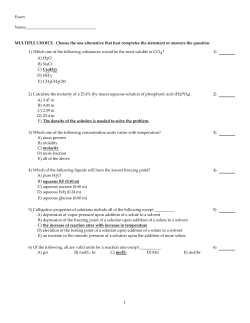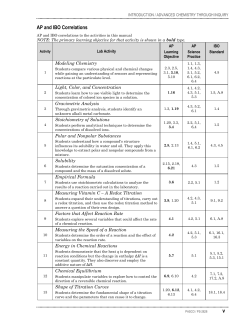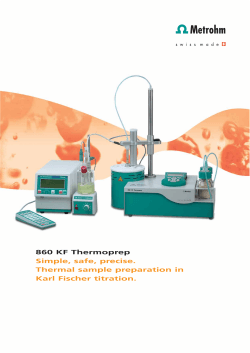
Document 263995
2 0 1 2 H C I C 1 H2 Chemistry 10. Atoms, Molecules, Stoichiometry and Redox When a sample of green potassium manganate(VI), K M n 0 , is added to aqueous sodium hydroxide, a brown black solid A and a purple solution of B are obtained. 2 4 (i) A contains 63.8% by mass of manganese and 36.2% by mass of oxygen. Determine the empirical formula of A. (ii) Suggest the identity of B and state the type of reaction that has occurred. (iii) Construct a balanced ionic equation for this reaction. (iv) 2.00 g of impure K M n 0 was added to excess aqueous sodium hydroxide and the brown black solid A was filtered off. The remaining solution was made up to a volume of 500 c m with distilled water. 25.0 c m of this solution was pipetted out and acidified with dilute H S 0 . The acidified solution requires 5.60 c m of 0.200 mol d m " aqueous iron(ll) sulfate for titration. Given that 1 mol of B reacts with 5 mol of F e , calculate the percentage purity of K M n 0 in the original sample. 2 4 3 3 2 4 3 3 2+ 2 4 Application of oxidation number and electron transfer in redox reaction 11. Sodium nitrate(lll), N a N 0 , is used as a preservative in meats and fish. It is very soluble in water and is slowly oxidized by oxygen in the air to sodium nitrate(V), N a N 0 . N a N 0 can also be converted to H N 0 by the action of dilute sulfuric acid. H N 0 is unstable and decomposes into N 0 , H N 0 and H 0 . 2 3 2 2 2 2 3 2 A student was required to show that N a N 0 as a preservative is unstable and is oxidised to N a N 0 . He carried out an experiment as described below. 2 3 1. Fill the burette with an aqueous solution containing 6.64 x 10" mol d m N a N 0 . 2. Using a pipette, measure out 25.0 c m of a 2.00 x 10" mol d m " K M n 0 into a conical flask. 3. Add 10 c m of sulfuric acid into the conical flask. 4. Titrate this solution against the N a N 0 solution in the burette. 2 3 - 3 2 2 3 4 3 2 He found that 18.80 c m of the N a N 0 solution was required to reach the end-point of the titration. 3 (i) 2 Calculate the number of moles of N a N 0 and K M n 0 used in the titration. Hence show that N a N 0 is oxidised to N a N 0 . Why was N a N 0 placed in the burette instead of the conical flask for titration in this experiment? Why was sulfuric acid used in step 3 instead of hydrochloric acid? Give the colour change at the end-point of the titration. Write a balanced equation for the reaction between N a N 0 and K M n 0 . 2 2 (ii) (iii) (iv) (v) 12. 4 3 2 2 4 An acidified solution of the salt KC/O (x = 1, 2 or 3) will oxidise Fe (aq) to Fe (aq) quantitatively, the chlorine being reduced to C/~(aq). When 0.150 g of the salt KC/O was reacted with 0.500 mol d m " Fe (aq) in the presence of H (aq), 11.3 c m of Fe (aq) was needed for complete reaction. x 2+ 3+ x 3 2+ + 3 2+ Calculate the value of x and construct an equation for the reaction between Fe (aq) and acidified KC/O (aq). 2+ x
© Copyright 2025




















![Sample Problem - Determining [H O ] and [OH ]](http://cdn1.abcdocz.com/store/data/000280168_1-c116352dd641f0f4df08f45137d4207d-250x500.png)
